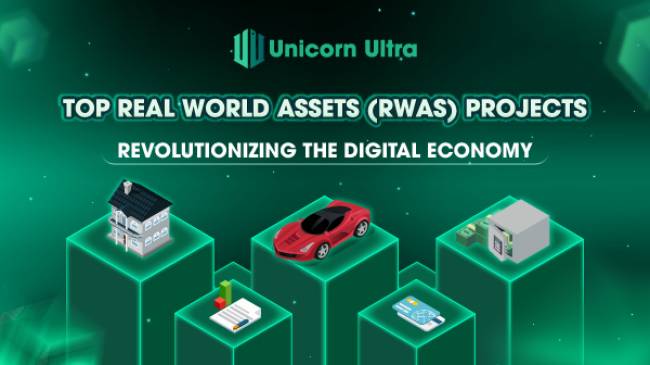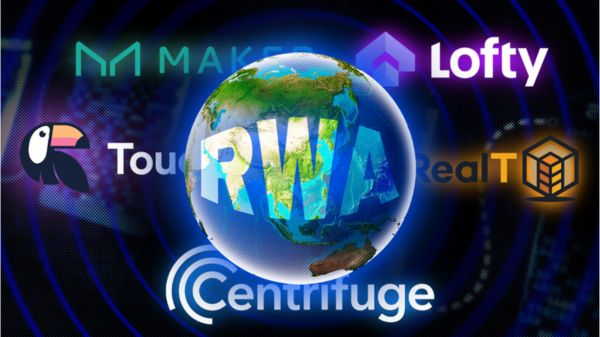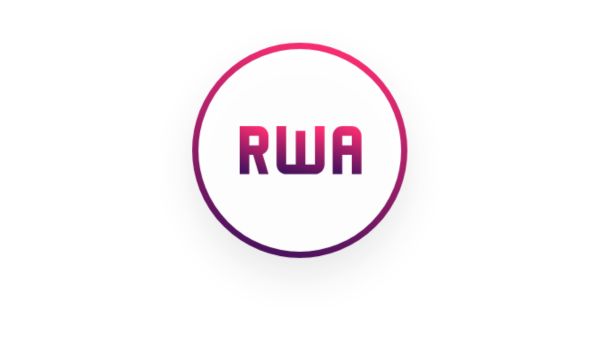The advent of blockchain technology has brought forth numerous innovations, with one of the most significant being the emergence of Real World Asset (RWA) projects. RWAs represent a bridge between the physical world and the digital realm, enabling the tokenization of traditional assets such as real estate, commodities, and more. In this article, we will delve into the concept of RWAs, explore how they work, examine their use cases, and highlight the top Real World Assets projects leading the way in this exciting field.
Table of Contents
Top Real World Assets Projects

MakerDAO (MKR)
MakerDAO is a decentralized autonomous organization that operates the Maker protocol, which enables the creation of stablecoins backed by collateralized assets. By locking collateral (such as cryptocurrencies) into smart contracts, users can generate stablecoins, most notably Dai (DAI). MakerDAO provides stability in an otherwise volatile cryptocurrency market.
Goldfinch (GFI)
Goldfinch is a decentralized lending platform that connects lenders and borrowers in emerging markets. By leveraging credit algorithms and risk assessments, Goldfinch enables borrowers to access capital without requiring traditional forms of collateral. The platform provides opportunities for financial inclusion in underserved regions.
Maple Finance (MPL)
Maple Finance is a decentralized platform that allows professional investors to lend funds directly to small and medium-sized enterprises (SMEs) globally. The platform enables investors to generate passive income while supporting the growth of SMEs in need of capital. Maple Finance operates on the Ethereum blockchain.
Centrifuge (CFG)
Centrifuge is a blockchain-based platform that tokenizes real-world assets, such as invoices and royalties, to unlock liquidity. The platform enables businesses to access capital quickly by selling their outstanding invoices to investors. Centrifuge offers a marketplace for trading these tokenized assets.
TrueFi
TrueFi is a decentralized protocol for uncollateralized lending. It allows borrowers to access uncollateralized loans while preserving the lender's capital through an incentivized staking mechanism. TrueFi leverages a reputation-based system and robust risk assessment methodologies to minimize default risk.
How Do Real-World Assets Work?
Real World Assets leverage blockchain technology to tokenize and represent traditional assets on the digital ledger. This tokenization process involves creating digital representations of the underlying assets, often referred to as security tokens or digital securities. These tokens are then issued on a blockchain network, providing the advantages of transparency, immutability, and fractional ownership.
By tokenizing RWAs, various barriers and inefficiencies of traditional financial systems are overcome. Ownership can be easily transferred, fractional ownership becomes possible, and liquidity is increased. Furthermore, smart contracts enable programmability and automation of certain financial activities, such as revenue distribution and loan repayments.
Real World Asset Use Cases

Real Estate Tokenization: Tokenizing real estate assets allows for increased liquidity, fractional ownership, and accessibility to a broader investor base. Investors can own fractions of high-value properties, and property owners can unlock capital by selling a portion of their property. Projects like Propy and RealT are pioneering this space.
Commodity-backed Tokens: Tokenizing commodities, such as gold or oil, enables investors to gain exposure to these assets without the need for physical possession. This allows for easier trading, improved liquidity, and increased accessibility to these traditional assets. Digix Global and Goldfinch are notable players in this arena.
Invoice Financing: RWAs can facilitate invoice financing by tokenizing invoices, allowing businesses to access capital by selling their outstanding invoices to investors. This streamlines the financing process, reducing the reliance on traditional financial institutions. Projects like Centrifuge and TrueFi are addressing this use case.
What are the benefits of investing in Real World Assets projects (RWAs)?
Investing in Real World Assets (RWAs) projects can offer several benefits to investors. Here are some key advantages:
- Tangible asset backing: RWAs are typically backed by tangible assets such as real estate, infrastructure, commodities, or revenue-generating businesses. Investing in RWAs provides a level of asset-backed security, as the underlying physical assets have inherent value and can act as a hedge against inflation and market volatility.
- Potential for stable income: Many RWAs generate regular income in the form of rent, lease payments, dividends, or interest. By investing in RWAs, investors may receive consistent and stable income streams, providing a reliable source of cash flow.
- Diversification: RWAs can offer diversification benefits to investment portfolios. By including real assets, investors can reduce the overall risk exposure to purely financial assets like stocks and bonds. Diversifying into RWAs can help improve the risk-reward profile of an investment portfolio and potentially enhance long-term returns.
- Inflation protection: Real assets, such as real estate or commodities, have historically demonstrated a positive correlation with inflation. Investing in RWAs can provide a hedge against inflation as the value of the underlying physical assets may rise in tandem with inflationary pressures, helping to preserve purchasing power.
- Potential for capital appreciation: While stability and income generation are primary benefits, some RWAs also offer the potential for capital appreciation. Real estate properties in high-demand areas, infrastructure projects in growing regions, or businesses with strong growth prospects can see an increase in value over time, providing investors with capital appreciation opportunities.
- Portfolio resilience: RWAs have shown resilience during economic downturns and market fluctuations. They tend to have lower volatility compared to purely financial assets, offering potential stability and downside protection during turbulent times.
- Social impact: Certain RWAs, such as sustainable infrastructure projects or social housing initiatives, can align with investors' social and environmental values. Investing in such projects can have a positive impact on society while generating financial returns.
- Access to alternative investment opportunities: RWAs provide access to investment opportunities beyond traditional stocks, bonds, and financial markets. They offer the chance to diversify into sectors and asset classes that may not be readily accessible through conventional investment vehicles.
It's important to note that investing in RWAs carries its own risks, including market fluctuations, liquidity constraints, regulatory considerations, and specific risks associated with the underlying assets. Investors should conduct thorough due diligence, assess their risk tolerance, and seek professional advice before making investment decisions in RWAs.
What are the risks of investing in Real World Assets projects (RWAs)?
Investing in Real World Assets (RWAs) projects carries certain risks that investors should be aware of. Here are some key risks associated with investing in RWAs:
- Market and economic risks: RWAs are subject to market and economic conditions that can impact their performance. Factors such as changes in interest rates, economic downturns, fluctuations in property or commodity prices, or shifts in consumer demand can affect the value and income potential of RWAs.
- Liquidity risk: RWAs typically have lower liquidity compared to traditional financial assets. Selling or exiting an investment in RWAs may take longer and be subject to limitations, depending on the asset class and market conditions. Investors may face challenges in converting their investments into cash when needed.
- Regulatory and legal risks: RWAs are subject to various regulatory frameworks, permits, licenses, zoning laws, and legal requirements. Changes in regulations or legal disputes related to the underlying assets can impact the value and viability of RWAs. It's important for investors to understand and comply with relevant laws and regulations governing the specific asset class or jurisdiction.
- Operational risks: RWAs may face operational risks related to their management, maintenance, or development. Factors such as mismanagement, inadequate maintenance, construction delays, or project execution risks can impact the financial performance and overall value of RWAs.
- Market valuation risks: Valuing RWAs can be challenging, as they often involve subjective assessments and assumptions. The valuation of real estate, infrastructure projects, or businesses may be influenced by factors such as market sentiment, appraisal methodologies, and liquidity conditions. Fluctuations in market valuations can impact the accuracy of asset pricing and the overall returns of RWAs.
- Financing risks: RWAs often rely on financing, such as mortgages, loans, or project financing, to fund their acquisition or development. The availability and cost of financing can be subject to market conditions and credit risk. Changes in interest rates, borrowing costs, or the inability to secure financing can impact the financial viability of RWAs.
- Environmental and sustainability risks: RWAs, particularly those involving natural resources or properties with environmental considerations, may face risks related to environmental regulations, climate change, or sustainability concerns. Changes in environmental regulations or increased scrutiny on carbon emissions and sustainability practices can impact the value and operation of RWAs.
- Concentration risk: Investing in a specific RWA or a limited number of RWAs can lead to concentration risk. If the performance of a particular asset or sector is adversely affected, the overall investment portfolio may experience significant negative impacts.
It's essential for investors to conduct thorough due diligence, assess their risk tolerance, and seek professional advice before investing in RWAs. Understanding the specific risks associated with the asset class, performing comprehensive analysis, and diversifying investments can help mitigate some of the risks involved.

How to choose a good RWAs project?
Choosing a good Real World Assets (RWAs) project requires careful consideration and due diligence. Here are some key factors to consider when evaluating RWAs projects:
1. Investment goals: Clarify your investment objectives, whether they are income generation, capital appreciation, diversification, or aligning with specific values or impact goals. Understanding your goals will help you narrow down the types of RWAs projects that are suitable for your investment strategy.
2. Asset class and sector: Evaluate the asset classes and sectors that interest you within the realm of RWAs. Common asset classes include real estate, infrastructure, natural resources, renewable energy, or revenue-generating businesses. Consider the potential risks and rewards associated with the specific asset class and sector you choose.
3. Location and market dynamics: Assess the location of the RWAs project. Look into the local market dynamics, such as supply and demand dynamics, economic growth prospects, regulatory environment, and infrastructure development. Understanding the local market conditions can provide insights into the potential performance and viability of the project.
4. Financial viability: Evaluate the financial aspects of the RWAs project, including projected cash flows, profitability, historical performance, and risk-return profile. Assess the financial projections, budgets, and funding sources to gauge the project's sustainability and return potential. Consider factors such as rental income, occupancy rates, operational costs, and financing terms.
5. Management team and expertise: Assess the experience, track record, and expertise of the project's management team. Look into their capabilities, industry knowledge, and their past successes in managing similar RWAs projects. A competent and experienced team can significantly impact the success and profitability of the project.
6. Due diligence and legal considerations: Conduct thorough due diligence on the RWAs project, including legal documentation, permits, licenses, and compliance with relevant regulations. Review any potential legal risks, contractual obligations, and potential liabilities associated with the project. Engaging legal professionals can help ensure a comprehensive understanding of the legal framework and mitigate legal risks.
7. Risk assessment: Evaluate the risks associated with the RWAs project, including market risks, liquidity risks, regulatory risks, operational risks, and environmental risks. Assess the risk management strategies and mitigation measures in place. Understand the potential downside risks and consider whether the potential rewards outweigh the risks involved.
8. Exit strategy and liquidity: Consider the potential exit options and liquidity of your investment. Evaluate the marketability and demand for the asset class you are investing in. Understand the process and timelines for divesting your investment and the potential returns you can expect upon exit.
9. Professional advice and research: Seek advice from professionals such as financial advisors, legal experts, and industry specialists who have experience in RWAs investments. Conduct thorough research, review market reports, and engage with trusted sources of information to gather insights and make informed decisions.
By considering these factors, conducting comprehensive due diligence, and seeking professional advice, you can make a more informed decision when choosing a good RWAs project that aligns with your investment goals and risk appetite.
How to invest in RWA projects?
Investing in Real World Assets (RWA) projects involves a process that typically includes the following steps:
1. Research and analysis: Start by researching and analyzing different RWA projects available in the market. Consider factors such as asset class, location, financial viability, management team, and risk-return profile. Look for projects that align with your investment goals and risk appetite.
2. Due diligence: Perform thorough due diligence on the selected RWA projects. This includes reviewing financial statements, project documents, legal contracts, permits, licenses, and any available market reports. Conduct site visits, if possible, to assess the physical condition and potential of the asset.
3. Investment strategy and planning: Define your investment strategy and plan based on your financial goals, risk tolerance, and investment horizon. Determine the amount of capital you are willing to invest in RWA projects and the allocation within your overall investment portfolio.
4. Seek professional advice: Consider seeking advice from professionals such as financial advisors, legal experts, and industry specialists. They can provide valuable insights, help evaluate risks, and guide you through the investment process. Their expertise can assist in making informed decisions and mitigating potential risks.
5. Evaluate investment structure: Assess the investment structure of the RWA project. This can include options such as direct ownership, investing through real estate funds, participating in syndications, or investing in real estate investment trusts (REITs). Each structure has its own benefits, risks, and requirements. Evaluate which structure aligns best with your investment strategy and preferences.
6. Funding the investment: Determine how you will fund your investment in RWA projects. This can involve using personal funds, seeking financing from banks or other lending institutions, or participating in crowdfunding platforms. Consider the financial implications, interest rates, and repayment terms associated with different funding options.
7. Legal documentation and contracts: Engage legal professionals to review and negotiate the legal documentation and contracts associated with your investment in RWA projects. This can include purchase agreements, shareholder agreements, loan agreements, or partnership agreements. Ensure that you fully understand the terms and conditions of the investment and seek legal advice when needed.
8. Monitor and manage your investment: Once you have invested in RWA projects, actively monitor and manage your investment. Stay informed about market conditions, track the performance of the project, and assess any changes that may impact your investment. Regularly review financial statements and engage with project managers to stay updated on the progress.
9. Exit strategy: Consider your exit strategy and plan for divesting your investment when the time is right. Evaluate potential exit options, such as selling the asset, participating in a secondary market, or holding the investment until maturity. Plan for contingencies and be prepared to adapt your strategy based on market conditions and your investment objectives.
It's important to note that investing in RWA projects carries risks, and it's advisable to conduct thorough research, seek professional advice, and diversify your investment portfolio to mitigate potential risks.
Conclusion
The top Real World Assets projects are revolutionizing the financial landscape by bridging the gap between traditional assets and the digital world. By leveraging blockchain technology, these projects enable the tokenization of real-world assets, unlocking liquidity, enhancing accessibility, and fostering innovation in the digital economy. As blockchain continues to mature, we can expect RWAs to play a pivotal role in reshaping finance, transforming industries, and empowering individuals worldwide. Follow U2U for more blockchain information!






